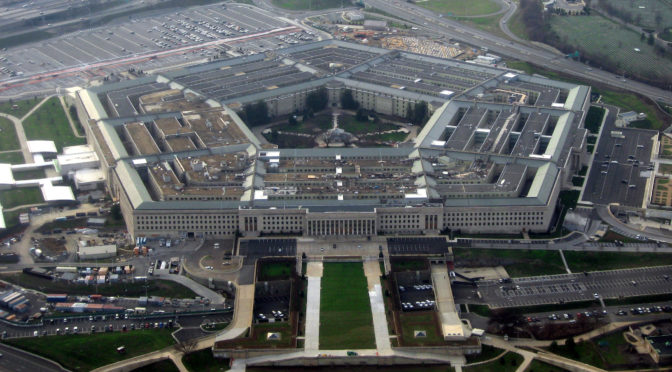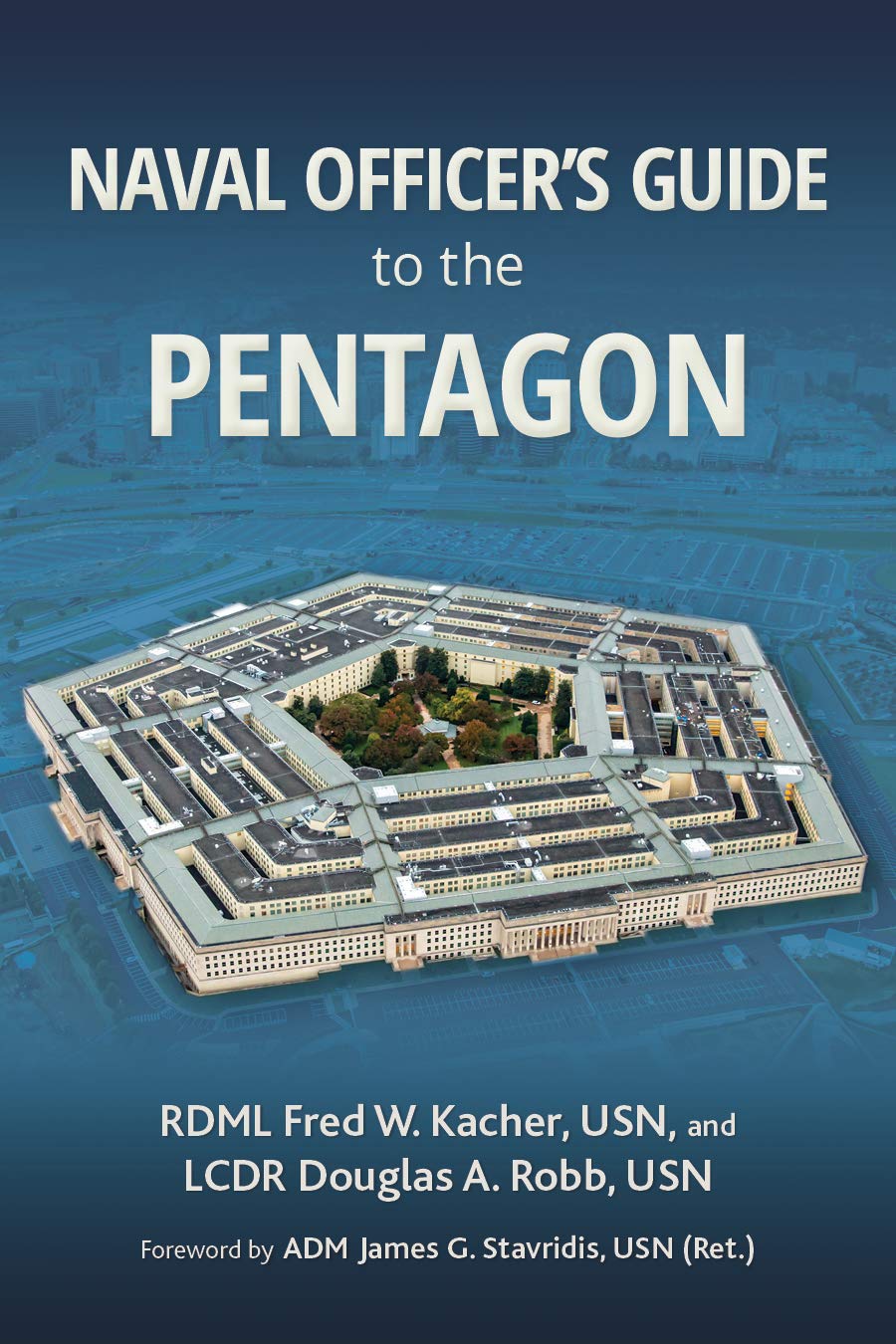By Dmitry Filipoff
CIMSEC had the opportunity to discuss with Rear Admiral Fred Kacher and Commander Doug Robb their new book, the Naval Officer’s Guide to the Pentagon. In this conversation they discuss what naval officers need to know when reporting to the Pentagon, how this book can serve as an excellent reference for a variety of roles, and what is unique about serving in the nation’s capital.
The introduction notes that this is the first ever edition of this book. What motivated you to take on this project, and how do you see a need for this book?
The U.S. Naval Institute’s Blue and Gold professional series has for years provided naval professionals—officers, enlisted, civilians, and their families—with helpful guides designed to ease acclimation to life and work in the Navy. This project was borne from a similar desire to help.
Initially, USNI envisioned a slightly narrower guide designed to help naval officers bound for the Pentagon’s Joint Staff. But as we thought about which jobs young leaders from the Fleet head to when they report to the Pentagon, we realized we needed to broaden the focus. As we looked around, there seemed to be only a single relevant preparatory book—Assignment Pentagon by retired Air Force Major General Perry Smith, first published in the late 1980s. It contained valuable information, but wasn’t geared specifically to naval officers or a Navy crowd. So we set out to describe the types of things—a history of the building, how to get around it, the different staffs and assignments one may be detailed to, other government branches and organizations, and information about the area—that a junior or mid-grade naval officer coming to Washington for perhaps the first time would need to know to really make an impact soon after reporting.
Although both of us remember our first tours at the Pentagon well, we also quickly realized that we didn’t have all the answers, so we sought out people from across the service whose professional backgrounds, past experiences, writing acumen, and desire to help made them natural partners for this project. The result is an anthology of sorts where some true subject matter experts break down complex topics in a way that will be useful to Washington-bound naval officers and civilians alike.
The Pentagon is the headquarters of the massive bureaucracy that is the Department of Defense. What key organizations and processes can someone familiarize themselves with to get a sense of who the key players are and understand the regular business of the building?
The answer to this question really lies in the way we’ve organized the book. In it, we describe the different staffs within the Pentagon with which naval officers or civilians work or interact, including the Navy (OPNAV) Staff, the Secretariat, the Office of the Secretary of Defense (OSD), and the Joint Staff. Additionally, chapters describe the types of jobs one may find themselves in, whether as an action officer or helping shepherd a senior leader through their day as a member of their staff.
One chapter in particular—on the budget process—translates what is often described as an arcane or confusing system into plain English. And as we’ve observed firsthand, there’s a lot about working in the Pentagon that is different from serving on a ship or in a squadron. It can seem like business is being conducted in a foreign language. As just one small example, we include 13 pages—13 whole pages—listing the various acronyms someone working in the Pentagon will need to be familiar with. It’s emblematic of how we tried to design the content in the book to help “flatten” the learning curve for newly-reporting officers and civilians and provide a resource they’ll find useful to consult during their tour.
Nearly every job in the Pentagon or in Washington requires an understanding of organizations and actors outside of the Pentagon—the Executive Branch (e.g. the White House and National Security Council), the interagency, Congress, think tanks, and others—and we delve into those, as well.
To newcomers, entering the Pentagon can be a daunting experience. What can someone do to hit the ground running in their new role?
For this book, we don’t anticipate many people will sit down and read it cover-to-cover—we certainly don’t expect them to. Rather, we think of it as a “ready reference” for folks to keep handy and consult when they need a quick fact or want to learn more about a particular topic or role.
For people reporting for the first time, a good place to start is Chapter 2, “Navigating the Pentagon.” This includes Frommer’s Travel Guide-like logistical details about how to plan your commute, where to enter the building, how to traverse its corridors by making sense of the building signs and naming conventions, where to eat, and where to find other services.
Over time, after you’ve settled into your office and begin to understand your role and how it fits into the broader organization and processes around you, other chapters can help accelerate your understanding and “de-code” some topics that folks before you have found important but perhaps a tad foreign when they were first encountered.
Finally, opportunities often arise for seasoned and high-performing officers to shift offices or positions within the Pentagon, so pulling this book off the shelf could help someone learn about a new job, prepare for an interview, or execute a new assignment.
A key theme that many of the authors touch on is the importance of working well with others outside the usual naval milieu, such as those from another service, a different agency, and from other countries. Why is the ability to work across these divides so important?
It sounds clichéd but in Washington, D.C. it truly is all about relationships. Perhaps one reason for this is that the scope of issues on which people work on in Washington are so broad that no one person—whether an action officer managing a portfolio or a senior leader responsible for a large organization—can affect change on their own. As a result, having a friend or colleague to call for advice, help, support, or advocacy can be invaluable as you seek to “move your ball down the field.”
But building those relationships and establishing trust takes a great deal of time—in fact, it often spans the entire length of one’s tour. Consequently, by starting a job having already done some preparatory reading on your new role, how your organization fits into the broader scheme, and the general processes that govern your job —in other words, the information we focus on in this book—you can start developing those relationships on Day One.
While most of the book focuses on serving at the Pentagon a significant part of it looks at roles “across the river,” where a person in uniform may be embedded within civilian staff and institutions. These can range from working at the White House, in a think tank, or with congress. What is valuable about these kinds of roles and experiences?
Just as the Pentagon could be considered the military’s “corporate headquarters,” so too is Washington, D.C. the center of all national policy- and decision-making (which extends well beyond just military matters). And so as Admiral Jim Stavridis (ret.) mentions in the book’s foreword, one of the rewarding things about service in Washington, D.C.—even for uniformed service-members—is the opportunity to work with, or even within, other organizations that impact our government and country.
Active duty personnel are assigned to the White House, National Security Council, State Department, Capitol Hill, think tanks, research organizations, and academic institutions—and are exposed to the deliberations, inner workings, and decisions that will affect the nation and, in some cases, the world. While these experiences are valuable, sending this cadre of officers back to the Fleet can not only help the Navy contribute more effectively to the interagency, but will also position these folks to take on greater responsibility in our organizations in the future.
It is noted throughout the book that a tour at the Pentagon and in the Washington D.C. area can be an especially rewarding experience. What is unique about the professional experience that can be earned through these tours?
While both of us enjoyed our first tours in the Pentagon, the reality is that like other officers we came from—and returned to—the operational Navy. One of the neat things about the United States Navy is that most warfare community career paths are designed so that officers have the opportunity to “do something different” ashore after serving at sea. As a result, working in the Pentagon and Washington, D.C. area not only provides naval officers a chance to learn how our “corporate headquarters” works, but also how the other instruments of power play a role in our country’s direction. To echo Fleet Admiral Ernest King, who once said, “Where the power is that is where the headquarters have to be,” it is important to understand how and why major decisions are made in the capital. But it is equally if not more important to take those insights back to the waterfront or flight line.
Finally, although you’ll hear an awful lot about D.C. highway traffic and Pentagon bureaucracy, the D.C. metropolitan area is also a really vibrant area with a Stanley Cup-winning hockey team, a World Series-champion baseball team, museums, restaurants, universities, great history, and some great and varied communities to live in.
Any final thoughts you would like to share?
Simply put, we wrote this book to help future young naval leaders coming to the Pentagon from the Fleet succeed and thrive. At sea, there is an old adage that leaders should leave a ship “better than they found it” and this book is our effort to do the same for those heading to the Pentagon. We hope that in helping the next generation of D.C.-bound naval leaders, we will also help build a cadre of officers who better serve the needs and interests of the naval profession. Because at the end of the day, the quality of the work and advocacy done in Pentagon directly impacts the Fleet and our Sailors where the real work of the Navy happens.
RDML Fred W. Kacher, USN, is an active duty naval officer who has commanded USS Stockdale (DDG 106), Destroyer Squadron Seven and is currently in command of Expeditionary Strike Group Seven, forward deployed to the Pacific. He is the author of the Newly Commissioned Naval Officers Guide, 1st and 2nd editions, in addition to numerous articles on naval leadership and management. He has also served at the White House and in multiple tours at the Pentagon.
CDR Douglas A. Robb, USN, is an active duty surface warfare officer whose next assignment is as Executive Officer in USS Spruance (DDG 111), homeported in San Diego, California. He attended graduate school in Washington and has subsequently served three tours there, including on Capitol Hill and in the Pentagon on the staff of the Chief of Naval Operations.
Dmitry Filipoff is CIMSEC’s Director of Online Content. Contact him at Content@cimsec.org.
Featured Image: The Pentagon, headquarters of the United States Department of Defense, taken from an airplane in January 2008. (David B. Gleason via Wikimedia Commons)


